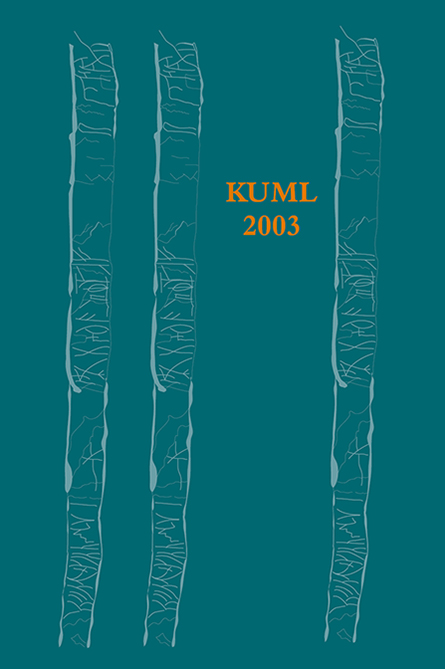Til bords med Marsk Stig – En oversigt over keramikken fra Hjelm
DOI:
https://doi.org/10.7146/kuml.v52i52.102645Nøgleord:
Marsk Stig, keramik, HjelmResumé
Dining with Marsk StigA survey of the Hjelm pottery
Potsherds occur frequently in nearly every excavation of a medieval settlement. Working with this abundance of sherds is usually a laborious job, but it is sometimes very rewarding. This was the case when during recent years the small island of Hjelm off the east coast of Jutland was excavated. The Hjelm excavation was published in 2002. However, the pottery is interesting enough to deserve special treatment.
The Hjelm pottery stems from the period between 1290, when the castles on Hjelm were built, and 1306, when King Erik Menved captured the island and burnt down the settlement. Consequently, an examination of the Hjelm pottery is important for two reasons: Firstly, because the castles were connected to a certain class, and secondly, because they had a very short lifetime. The amount of pottery found on Hjelm is not large. In all, 854 sherds were found during the excavations of Fyrbakken (the Lighthouse Hill), Kastelbakken (the Citadel Hill), Møntværkstedet (the Mint), and certain areas in the open landscape (fig. 1). The pottery finds consist of glazed jugs for the table, unglazed, grey cooking pots, and a number of colourful, imported jugs for serving and drinking. There are relatively few rim types represented, which may be due to the short lifetime of the castles (fig. 2). The glazed jugs have a plastic decoration of strips, scales, or ‘raspberries’ – all known from a number of other finds (figs. 3, 4, 5, and 6). A visual examination of the fabric indicates that the majority of the domestic pottery was made by potters on the Djursland peninsula. Apart from the domestic pottery, there is a considerable amount of imported white fabric jugs and early stoneware (fig.7), such as polychrome white fabric jugs from Rouen and Saintonge (fig. 8) and early stoneware jugs made in the Rhine and Weser areas (figs. 9 and 10). In view of the dating of the castles, it is interesting that only early stoneware occurs on the island, whereas completely sintered stoneware is absent. This indicates that ‘proper’ stoneware did not reach the area until the early 14th century. The variation within the imported pottery is considerable, with pottery from many different places of origin. This suggests that Marsk Stig (Lord High Constable Stig Andersen) and his men attached importance to the maintenance of a cosmopolitan lifestyle with an emphasis on the pleasures of the table, on status, and on demonstrating power.
Jette Linaa Larsen
Moesgård Museum
Translated by Annette Lerche Trolle
Downloads
Publiceret
2003-12-14
Citation/Eksport
Larsen, J. L. (2003). Til bords med Marsk Stig – En oversigt over keramikken fra Hjelm. Kuml, 52(52), 227–246. https://doi.org/10.7146/kuml.v52i52.102645
Nummer
Sektion
Artikler
Licens
Fra og med årgang 2022 er artikler udgivet i Kuml med en licens fra Creative Commons (CC BY-NC-SA 4.0).
Alle tidligere årgange af tidsskriftet er ikke udgivet med en licens fra Creative Commons.


